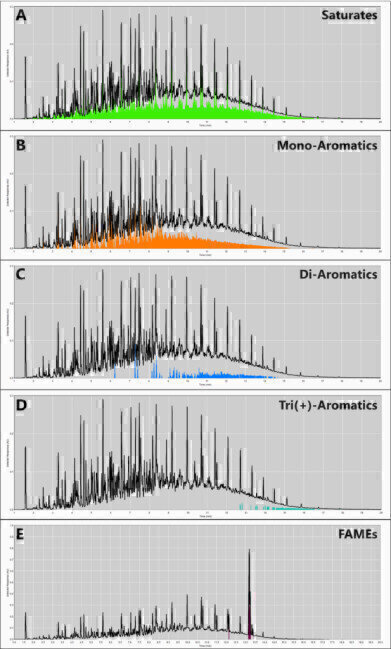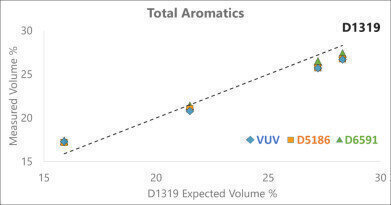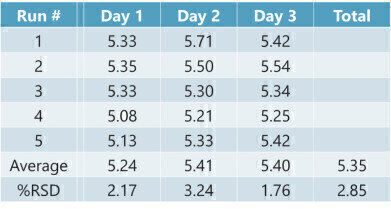-
 Figure 1. GC-VUV can utilize the power of Time Interval Deconvolution™ to spectrally determine the total saturate (A), total mono-aromatic (B), total di-aromatic (C), and total tri(+)-aromatic (D) content of a typical diesel fuel. The total FAME content of biodiesel-spiked fuels (B05-B15) can also be determined (E).
Figure 1. GC-VUV can utilize the power of Time Interval Deconvolution™ to spectrally determine the total saturate (A), total mono-aromatic (B), total di-aromatic (C), and total tri(+)-aromatic (D) content of a typical diesel fuel. The total FAME content of biodiesel-spiked fuels (B05-B15) can also be determined (E). -
 Figure 2. The quantitative results for total aromatics of 4 proficiency samples using GC-VUV and the 3 current ASTM methods. GC-VUV compares well to both the SFC and HLPC methods, which are the methods most used for diesel certification.
Figure 2. The quantitative results for total aromatics of 4 proficiency samples using GC-VUV and the 3 current ASTM methods. GC-VUV compares well to both the SFC and HLPC methods, which are the methods most used for diesel certification. -
 Table 1. A preliminary precision study to quantitate total FAMEs in a biodiesel-spiked fuel (5.0% v/v). Intra-day repeatability and total precision over 3 days are both good, with all %RSDs below 3.5%.
Table 1. A preliminary precision study to quantitate total FAMEs in a biodiesel-spiked fuel (5.0% v/v). Intra-day repeatability and total precision over 3 days are both good, with all %RSDs below 3.5%.
Analytical Instrumentation
Diesel & Biodiesel on the VUV Analyzer™ Platform: A Preview
Sep 15 2020
After VUV Analytics published methods for the certification of both gasoline (ASTM D8071) and jet fuel (ASTM D8267), the next natural step was to diesel, where we find a lot of the same test method players as in jet fuel testing: FIA (D1319), SFC (D5186), and HPLC (D6591). We’re all aware of the problems with D1319, and many people in the industry are ready to phase it out completely. SFC and HPLC are both solid methodologies for aromatics determination, but they falter with biodiesel-spiked diesel fuels. With the industry looking to enhance more environmentally friendly initiatives, the need to not only analyse samples containing biodiesel, but also to analyse and characterize the biodiesel itself is quickly becoming a priority.
From D8267 we know we can already analyze aromatics as well or better than the other methodologies, and we’ve also done substantial work into characterising fatty acid methyl esters (FAMEs) in both food and pure biodiesel. Our goal with this diesel method is to maintain the same speed, accuracy, and precision from D8267 while offering what no other method can: the ability to characterise and quantitate the FAME content of added biodiesel.
The basis for this method uses the analysis conditions for D8267, but because diesel covers a higher carbon range than jet fuel, the final oven temperature is held for an additional 11 minutes (for a total run time of 25 minutes), and the spectra library is extended out to C30. However, the analysis is essentially the same as D8267: the VUV absorbance spectra for saturates, mono-aromatics, di-aromatics, and tri(+)-aromatics are distinct from one another, allowing for reliable spectral matching even when dozens of analytes are co-eluting.
Figure 1 shows the results of a diesel analysis via VUV Analyze™ Software. Using Time Interval Deconvolution™ to match and quantitate the measured absorbance spectra, total mass and volume percent can be determined for saturates (total) and aromatics (mono-, di-, tri(+)-, and total). This method compares well with the other methodologies, notably SFC and HPLC, as seen in Figure 2.
Additionally, samples that contain spikes of biodiesel in the 2 - 20% volume range can be analyzed with this method to determine not only saturates and aromatics but also total fatty acid methyl ester (FAME) content (Figure 1E). A preliminary precision study for FAME quantitation was performed on a 5% biodiesel-spiked diesel fuel, and both the intra-day precision over 3 days and the total precision are less than 3.5% (Table 1). The average FAME concentration (5.35%) is slightly above the target concentration (5.0%).
This method is still a work in progress, and we will continually increase both the range and the accuracy of the biodiesel quantitation. We also hope to include individual FAME speciation in some capacity, since many labs we’ve spoken with need to know and verify the source of their biodiesel (soy, canola, palm, tallow, etc.). Stay tuned for more updates as we receive updates from ASTM on the current method we have balloted.
By: Alex Hodgson
Digital Edition
PIN 25.4 Aug/Sept
September 2024
Analytical Instrumentation - Novel and Rapid LSC method for the analysis of biogenic carbon in fuels Measurement and Testing - Matrix evaluation on the Xplorer-V with Vectra autosampler accordi...
View all digital editions
Events
Nov 04 2024 Abu Dhabi, UAE
Nov 04 2024 Kigali, Rwanda
Nov 05 2024 Toronto, Canada
Nov 05 2024 Paris, France
Nov 12 2024 Cologne, Germany


















